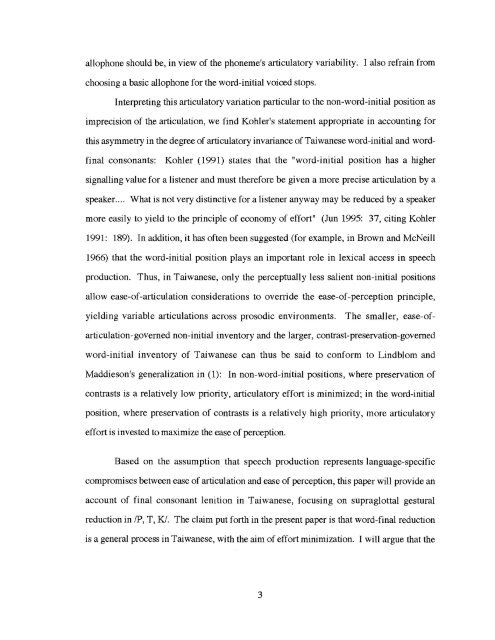A Phonetically-Based Optimality Theoretic Account of Consonant ...
A Phonetically-Based Optimality Theoretic Account of Consonant ...
A Phonetically-Based Optimality Theoretic Account of Consonant ...
Create successful ePaper yourself
Turn your PDF publications into a flip-book with our unique Google optimized e-Paper software.
allophone should be, in view <strong>of</strong> the phoneme's articulatory variability. I also refrain from<br />
choosing a basic allophone for the word-initial voiced stops.<br />
Interpreting this articulatory variation particular to the non-word-initial position as<br />
imprecision <strong>of</strong> the articulation, we find Kohler's statement appropriate in accounting for<br />
this asymmetry in the degree <strong>of</strong> articulatory invariance <strong>of</strong> Taiwanese word-initial and word<br />
final consonants: Kohler (1991) states that the "word-initial position has a higher<br />
signalling value for a listener and must therefore be given a more precise articulation by a<br />
speaker .... What is not very distinctive for a listener anyway may be reduced by a speaker<br />
more easily to yield to the principle <strong>of</strong> economy <strong>of</strong> effort" (Jun 1995: 37, citing Kohler<br />
1991: 189). In addition, it has <strong>of</strong>ten been suggested (for example, in Brown and McNeill<br />
1966) that the word-initial position plays an important role in lexical access in speech<br />
production. Thus, in Taiwanese, only the perceptually less salient non-initial positions<br />
allow ease-<strong>of</strong>-articulation considerations to override the ease-<strong>of</strong>-perception principle,<br />
yielding variable articulations across prosodic environments. The smaller, ease-<strong>of</strong><br />
articulation-governed non-initial inventory and the larger, contrast-preservation-govemed<br />
word-initial inventory <strong>of</strong> Taiwanese can thus be said to conform to Lindblom and<br />
Maddieson's generalization in (1): In non-word-initial positions, where preservation <strong>of</strong><br />
contrasts is a relatively low priority, articulatory effort is minimized; in the word-initial<br />
position, where preservation <strong>of</strong> contrasts is a relatively high priority, more articulatory<br />
effort is invested to maximize the ease <strong>of</strong> perception.<br />
<strong>Based</strong> on the assumption that speech production represents language-specific<br />
compromises between ease <strong>of</strong> articulation and ease <strong>of</strong> perception, this paper will provide an<br />
account <strong>of</strong> final consonant lenition in Taiwanese, focusing on supraglottal gestural<br />
reduction in IP, T, KI. The claim put forth in the present paper is that word-final reduction<br />
is a general process in Taiwanese, with the aim <strong>of</strong> effort minimization. I will argue that the<br />
3
















